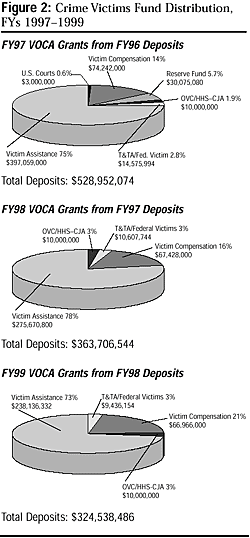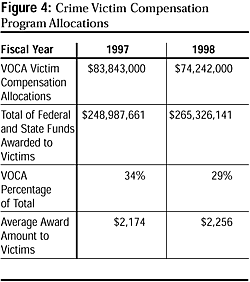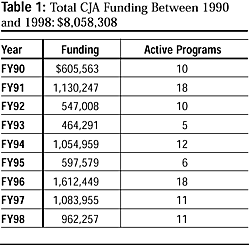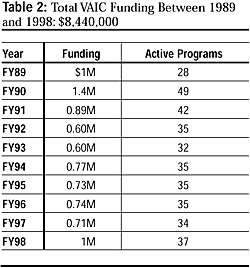- Formula Grants—State Compensation and Assistance Division
Funding Direct Services
- Discretionary Grants Program
- Federal Crime Victims Division (FCVD)—Helping Federal Crime
Victims
- Special Projects Division (SPD)—Training and Technical
Assistance/Demonstration Programs
- Grants to Indian Country
- Conclusion
When Congress passed the Victims of Crime Act (VOCA) in 1984, it created two methods for funding crime victim programs: (1) formula grants for States and territories to establish and operate crime victim assistance and compensation programs, and (2) discretionary grants for training and technical assistance. Later, VOCA was amended to give OVC authority to fund demonstration projects and evaluation efforts. Figure 2 shows Crime Victims Fund distribution for FYs 1997–1998 based on deposits from the immediately preceding years.

Formula Grants—State Compensation and Assistance Division Funding Direct Services
The VOCA victim assistance and victim compensation programs are administered by OVC's State Compensation and Assistance Division—the division responsible for the full range of grant monitoring activities, along with technical assistance and program and policy development. In FYs 1997 and 1998, unprecedented funds were made available to support victim assistance and compensation programs—more than 3 1/2 times over the record-setting collections of the previous biennium. Understanding the impact of this increase on States, OVC undertook several initiatives to prepare them to effectively manage these funds and expand and enhance services for crime victims.
OVC's leadership included a recommendation, acted upon by Congress, that States be given an additional year to expend victim assistance funds, starting with grants awarded in FY 1997. An earlier legislative change, precipitated by OVC leadership, allowed for a 5-percent administrative cost allowance. States took full advantage of this change in FY 1997; for the first time, many States hired grant coordinators and monitors, conducted needs assessments, and planned for effective use of funds over several years to stabilize programs. VOCA victim assistance administrators also used these funds to train and provide technical assistance to victim services providers, and many administrators automated their operations to facilitate grants management. OVC consistently urged States to develop long-range funding strategies to sustain and continue development of services for crime victims—and the States followed through.

In FYs 1997–1998, OVC distributed more than $524 million to States through VOCA victim assistance grants (see Appendix 2, "Year-of-Award Allocations for VOCA Victim Assistance Grants, FYs 1997 and 1998"). States used these funds to continue basic services, expand services to additional crime victim populations and geographic areas, and stabilize programs by planning for multiple-year funding. Funds subgranted to nonprofit and public organizations supported direct services to victims of domestic violence, sexual assault, child abuse, drunk driving, robbery, physical assault, elder abuse, and other crimes of violence (see Figure 3). As Figure 3 shows, over the last 2 biennia, law enforcement and prosecutors' offices received increasing numbers of VOCA subgrants, with dramatic increases in prosecutor-based programs. The majority of nonprofit and government subgrantees were rape crisis center and domestic violence shelter programs (see chapter 8 for a discussion of victim assistance trends).
All 50 States, the District of Columbia, and the U.S. Virgin Islands operate crime victim compensation programs. During FYs 1997–1998, many States added coverage for expenses such as crime scene cleanup, relocation of domestic violence victims, child care, sexual assault evidence collection, and catastrophic expenses. In FYs 1997–1998, States spent more than $356 million of their own money on crime victim compensation. During those same years, VOCA compensation contributed some $158 million to those programs. Under VOCA, victim compensation programs may receive an allocation of 40 percent of the State funds expended in the prior year (see Appendix 3, "Year-of-Award Allocations for VOCA Victim Compensation Grants, FYs 1997 and 1998"). Figure 4 depicts the amount of funds available to State crime victim compensation programs from State and Federal sources and the average amount awarded to victims per claim in FY 1997–1998.
The average payout during the biennium increased by approximately $90 per claim over the previous biennium. The number of claims paid increased by nearly 3 percent from 1997 to 1998, although at the same time crime decreased nationally. OVC believes that this increase in claims paid reflects State compensation program efforts to aggressively reach out to previously unserved victim populations. (See chapter 8 for a discussion of VOCA victim compensation trends.)
Discretionary Grants Program
Although OVC distributes funds to support victim services, mainly by formula grants to the States, it awards a small fraction of CVF discretionary dollars to public and private nonprofit organizations. These organizations, in turn, support the delivery of services to Federal crime victims, improve national-scope training and technical assistance projects, and support demonstration projects, as prescribed by VOCA.

Discretionary grant programs are administered
by two divisions within OVC: the Federal Crime Victims Division (FCVD) and the Special Projects Division (SPD). OVC, through its FCVD, also administers grants directly to Indian Country through its Victim Assistance in Indian Country (VAIC)
and Children's Justice Act (CJA) Partnerships for Indian Communities discretionary grant programs. Both programs foster systemic change, initiate victim assistance programs, and make services available to abused children within American Indian communities.
Federal Crime Victims Division (FCVD)—Helping Federal Crime Victims
Since the Presidential Directive of 1996 that set the path toward improving compliance with Federal statutes governing the provision of
services and rights to crime victims, the Federal criminal justice system is being held to a higher standard than ever before. OVC was the power behind this push, while the FCVD provided the "spark" to make it happen in the Federal community by ensuring greater participation in the justice system by crime victims, facilitating and
funding unmet needs, and reaching out to remote populations. Several efforts in FYs 1997–1998 strengthened this momentum, particularly those designed to help Federal agencies comply with their victim/witness responsibilities. Congress authorized $21 million in unexpended National Fine Center moneys to be returned to the CVF and made available to OVC to improve services
to crime victims in the Federal criminal justice system by hiring victim/witness coordinators in U.S. Attorney's offices; establishing an automated victim information and notification system for Federal cases; and collecting, enforcing, and
processing restitution orders.
 The average payout during the biennium increased by approximately $90 per claim over the previous biennium. The number of claims paid increased by nearly 3 percent from 1997 to 1998, although at the same time crime decreased nationally.
The average payout during the biennium increased by approximately $90 per claim over the previous biennium. The number of claims paid increased by nearly 3 percent from 1997 to 1998, although at the same time crime decreased nationally.

|
In FYs 1997–1998, OVC continued to use training and technical assistance dollars to educate and train Federal system professionals to enhance their capabilities, professionalize the field, and improve the response of all those who work with crime victims in the Federal criminal justice system. Outreach efforts have improved DOJ's capacity to expand to Federal communities outside of law enforcement, reaching all Federal agencies with victim/witness responsibilities. OVC is continuing to expand the vision of Federal agencies, some of which did not recognize the extent to which they come into contact with victims of Federal crime.
OVC, through the work of FCVD, continued to reach out to remote populations, especially Indian Country, where it enhanced and expanded programs, improved services, and implemented victims' rights initiatives. FCVD also funded unique demonstration programs to develop and help replicate promising practices in other service delivery areas, including military environments. In FYs 1997–1998, OVC continued to
target unmet needs for Federal crime victims,
providing resources (i.e., through emergency assistance funds) where none were available or where funding and support were inadequate.
 OVC was the power behind this push, while the FCVD provided the "spark" to make it happen in the Federal community by ensuring greater participation in the justice system by crime victims, facilitating and funding unmet needs, and reaching out to remote populations.
OVC was the power behind this push, while the FCVD provided the "spark" to make it happen in the Federal community by ensuring greater participation in the justice system by crime victims, facilitating and funding unmet needs, and reaching out to remote populations.

|
Special Projects Division (SPD)—Training and Technical Assistance/Demonstration Programs
The mission of SPD centers on providing training and technical assistance for the victims field, promoting public awareness of victims' issues, and disseminating information to assist crime victims and the allied professionals who serve them. SPD also sponsors demonstration projects and special initiatives that address related emerging issues and unmet needs.
A major OVC emphasis over the past 2 fiscal years that will continue into the future is identifying underserved populations, such as victims with disabilities, elder victims, fraud victims, and other victim populations traditionally overlooked by mainstream victim services programs and criminal justice serving professionals. SPD is committed to identifying the various points of entry where victims may obtain access to help and to improving the information provided to them at these critical points. By modeling best services at demonstration sites, such as through its VS 2000 program, OVC is helping to expand points of entry and integrate access to systems for crime victims.
Other FYs 1997–1998 focus areas for OVC through SPD included victims of juvenile offenders and gang violence, sexual assault, and stalking; needs culturally diverse victim population; and victims of child abuse and domestic violence. OVC-sponsored training and technical assistance projects are available to victim advocates, health and mental health professionals, law enforcement, judges, probation/parole officers, and prosecutors nationwide. In FYs 1997–1998, training on such topics as community crisis response, victim-centered mediation, and traumatic grief helped victim services providers formulate effective responses to the rights and needs of crime victims. OVC continues to invite the field to generate new ideas and to elicit the involvement of new groups of professionals to establish services for crime victims within their respective disciplines.

Grants to Indian Country
Disclosure of extensive child sexual abuse in reservation boarding schools and several multiple-victim child molestation cases on Indian reservations resulted in an amendment to VOCA in 1986 authorizing OVC to use a portion of the funds allocated from the CVF for programs to improve the investigation and prosecution of child sexual abuse in Indian Country, under the Children's Justice Act (CJA). CJA funds are awarded to federally recognized Tribes through a competitive grant process. OVC commits funding support for 3 years, contingent upon the grantee's satisfactory performance and the availability of funds. Since its inception in 1989, the CJA program has provided over $8 million to support Tribes and Tribal organizations (see Table 1). See Appendix 4 for a list of the FY 90 through FY 98 CJA grantees.
Table 1 shows total dollars awarded to Tribes, from FY 1990 through FY 1998, under the Children's Justice and Assistance Act Discretionary Grant Program for American Indians. In FY 1998, OVC changed the name of its CJA program to "Partnerships for Indian Communities,"
reflecting its intent to form a partnership with American Indian communities in Indian Country to identify issues and needs of child victims and to solve problems in the investigation and prosecution of child abuse cases and in the delivery of services to child victims and their families.
 In FYs 1997–1998, OVC continued to use training and technical assistance dollars to educate and train Federal system professionals to enhance their capabilities, professionalize the field, and improve the response of all those who work with crime victims in the Federal criminal justice system.
In FYs 1997–1998, OVC continued to use training and technical assistance dollars to educate and train Federal system professionals to enhance their capabilities, professionalize the field, and improve the response of all those who work with crime victims in the Federal criminal justice system.

|
OVC created the Victim Assistance in Indian Country (VAIC) program to establish permanent, accessible, and responsive victim assistance services on reservations governed by Federal criminal jurisdiction. OVC's VAIC program fills a critical gap—the lack of victim assistance programs "on reservation" and in remote parts of Indian Country, where violence is higher than in any other ethnic group (BJS 1999). OVC provides funding directly to Indian Tribes to help them establish reservation-based victim assistance programs in Indian Country.
 In FY 1997, OVC also announced its first competitive grants award process for VAIC, applying an additional $260,000 for a total of
$1 million in Federal funding for VAIC in FY 1998.
In FY 1997, OVC also announced its first competitive grants award process for VAIC, applying an additional $260,000 for a total of
$1 million in Federal funding for VAIC in FY 1998.

|
From 1988 until 1996, OVC awarded VAIC grants to State agencies for subgranting to Indian Tribes or Tribal organizations. In FY 1997, OVC modified the program so that Tribes received funding directly from OVC in the amount of $740,000. In FY 1997, OVC also announced its first competitive grants award process for VAIC, applying an additional $260,000 for a total of $1 million in Federal funding for VAIC in FY 1998. As part of its continuing push to improve Tribal commitment issues, beginning with FY 1998, discretionary grants required that the grantee provide an in-kind match to enhance the Tribe's ability to institutionalize the program from the beginning of the grant award process.
OVC continues to encourage State VOCA victim assistance administrators to fund services for crime victims in Indian Country with formula grant funding received from the CVF. OVC also works closely with State crime victim compensation programs and the National Association of Crime Victim Compensation Programs (NACVCP) to ensure that American Indian crime victims have access to financial assistance for out-of-pocket expenses related to their victimization.

Since its inception in 1988, the VAIC program has provided more than $8.4 million to establish 52 new programs with Tribes and Tribal organizations and has supported training to assist the Tribes with program development and implementation (see Table 2). See Appendix 5 for a list of FYs 1997 and 1998 VAIC grantees.
Conclusion
The programs, authorized by VOCA and developed or benefited from the growth of the Crime Victims Fund, have led to a wide variety of Federal efforts that assist our Nation's crime victims. There is a direct correlation between the efforts on behalf of crime victims at the Federal level prompted by Congress and the many advances recognized for victims at the Tribal, State, and local levels. The passage of 31 State constitutional amendments for victims' rights,
the creation of State crime victims funding mechanisms, and the formation of statewide victim coalitions are three examples of how Federal national efforts have positively influenced efforts to improve the status of crime victims.
Bipartisan support for victims' issues in Congress, a strong national victim advocacy coalition, and the determined voices of crime victims for equal treatment and services will ensure that victims' rights issues will remain an important issue for legislators, policymakers, communities, and victim advocates well into the next millennium.



